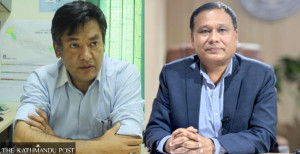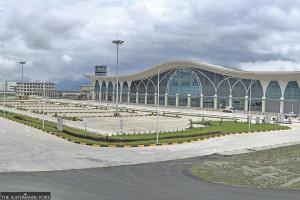National
Why waste obstruction at Bancharedanda recurs and what the new deal means
Several unfulfilled promises, and a pending vandalism case against locals triggered the latest blockade, which has ended for now with an 11-point deal.
Arjun Poudel
Garbage collection in Kathmandu Valley and parts of Kavrepalanchok district has resumed after authorities signed an 11-point agreement on Thursday evening with locals of Nuwakot and Dhading districts who had been blocking access to the Bancharedanda landfill.
The Valley’s waste management has been a recurring problem for over two decades. In the past, people living around the landfill site obstructed waste disposal to put pressure on the authorities to fulfill their demands concerning development projects, acquisition of land affected by the landfill, compensation and health services.
These protests had largely subsided after Kathmandu mayor Balendra Shah promised to honour previous agreements reached with protesters and address their new concerns following his election in 2022.
Obstruction in waste disposal resumed again over the last three weeks.
Here is all you need to know about the latest obstruction and the agreement reached with the agitating locals.
Latest obstruction in waste disposal
Asking the government to honour an 18-point agreement signed around three years ago, people from the landfill-affected areas of Nuwakot and Dhading districts, starting October 29, barred trucks carrying garbage from going near the landfill site.
This time, chairs of eight affected wards themselves came to the streets to block the garbage trucks. The obstruction halted door-to-door garbage collection in Kathmandu for around four days.
The Kathmandu metropolis had to appeal to city residents not to discard waste on the streets.
On November 2, Minister for Urban Development Kulman Ghising pledged to withdraw cases filed against local youths charged with vandalising garbage-carrying trucks in the past and to address other demands within 15 days—all to persuade locals to end the obstruction. As demanded, Ghising himself visited the affected areas on November 2 and held discussions with the agitators.
But when their demands were not addressed, they resumed the obstruction from Wednesday.
Ghising personally took the initiative to clear the obstruction on Wednesday and Thursday, and brokered an 11-point deal, which has ended the blockade, for the time being.
Old and new agreements
The 18-point agreement signed three years ago included the acquisition of land affected by the landfill. It was agreed that the government would acquire the 1.5 sq km area around the landfill site by compensating owners.
Thursday’s new agreement also includes fast-tracking the environmental impact assessment for land acquisition.
Compensation for past waste-related damage, improving health services and infrastructure in affected areas, supplying medicines and doctors, strengthening school infrastructure, development works, and road repairs are among other recurring issues included in every agreement.
This time, the KMC has agreed to double yearly grants provided to two local units—from Rs30 million to Rs60 million.
The central issue of both the 18-point and 11-point agreements is the commitment to withdrawing cases against two locals accused of vandalising garbage trucks and heavy equipment used in waste management in August 2022.
“They have assured us that the cases will be withdrawn immediately and our other demands met at the earliest,” said Nirajan Sanjel, a local resident from the affected area of Dhunibeshi Rural Municipality in Dhading district.
Sanjel is one of those accused of vandalising garbage trucks.
KMC officials on new obstruction
Officials at the KMC’s environment department said the new obstruction was instigated by two youths against whom criminal cases have been lodged for vandalising garbage trucks and other vehicles.
They said locals had obstructed waste disposal at Bancharedanda when the dumping site first came into operation around three years ago, putting forth various demands. Some youths had vandalised 18 vehicles including the metropolis’s bulldozer, excavators and garbage trucks. The KMC had filed cases against some of those involved in the act.
“One youth against whom a criminal case has been lodged returned to Nepal from Malta a few months ago,” said Uddhab Nepal, site in-charge of the Bancharedanda landfill. “When he learned that he cannot return to Malta without withdrawal of the case, he provoked locals and created obstruction.”
23 local units discard waste in Bancharedanda
Along with the Kathmandu Metropolitan City, 22 other local units—all from Kathmandu, Lalitpur and Bhaktapur, as well as Kavrepalanchok’s Banepa, Dhulikhel and Mandan Deupur municipalities dispose waste at Bancharedanda. Over 200 garbage trucks dump waste every day.
When there is obstruction at the landfill site, waste collection and disposal of all 23 local units are affected.
According to a KMC estimate, the 18 local units in the Kathmandu Valley generate over 1,200 metric tons of solid waste daily. Of that, 50 percent is generated from KMC alone.
KMC officials said that even though 22 other local units also use the landfill site, KMC has to address locals’ demands during every protest.
Locals say obstructing waste disposal not a choice
Amrit Lama, a local from Digaun, the most affected village in Dhunibeshi Rural Municipality, has rented a room at Banasthali Kathmandu, as his family has been practically displaced by the dumping site. Lama’s home is within 100 metres of the landfill.
“Obstructing waste disposal is not our choice,” complained Lama. “We have to tolerate the stench all the time, sleep wearing masks, and see piles of waste all the time.”
According to other locals, flies, crows, kites, stray dogs and jackals from the dumping site have made the village uninhabitable. Farmland has been damaged by leachate flowing from the site, and animals have died from drinking contaminated water.
“Neither does anyone want to buy our land, nor can we mortgage it at a bank,” complains Lama.
Changed political context
This time, elected representatives from the affected areas backed the agitating locals. KMC officials say that local representatives joined and supported the protest as they were elected by local voters and must consider their political future.
Officials say that in the past local politicians used to discourage residents from obstructing waste disposal as they belonged to the same parties that headed the government, but things are different now, after a non-partisan interim government was installed following the Gen Z uprising that toppled the UML-Congress coalition in September.
“We all know that politics in waste management is not new in Nepal,” said a KMC official on condition of anonymity, as he is not authorised to speak on political matters. “Changes in national politics definitely affect many issues including waste disposal.”




 16.12°C Kathmandu
16.12°C Kathmandu














